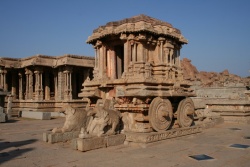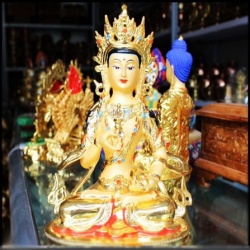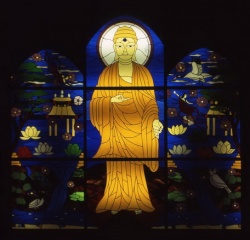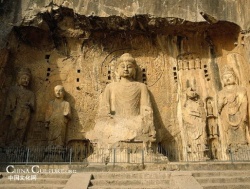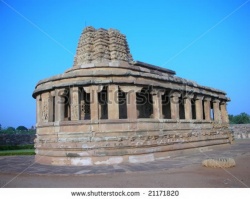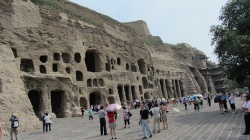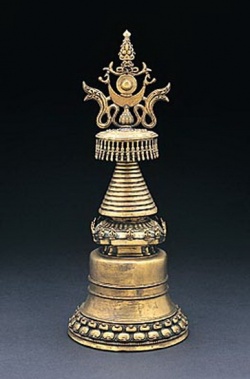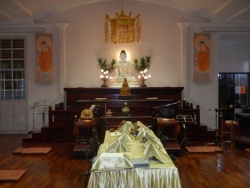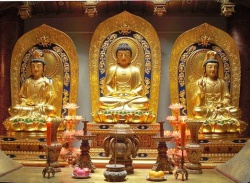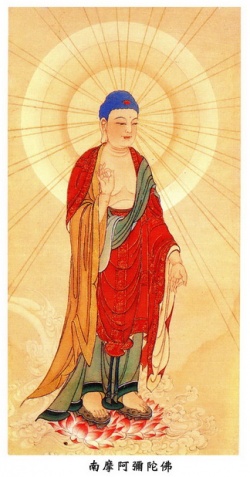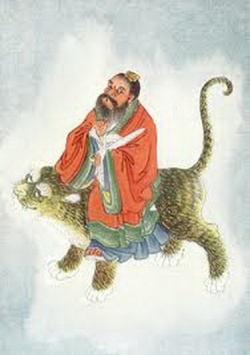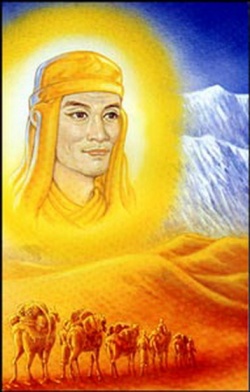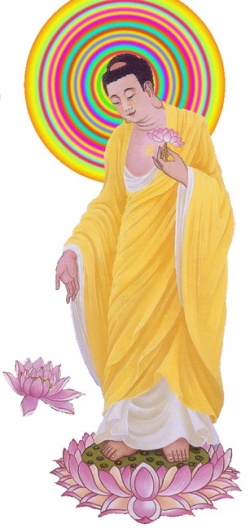The Yuezhi and Dunhuang (月氏与敦煌)
As is well known, the Yuezhi was also named as the Great Yuezhi, Yuzhi or Rouzhi in ancient Chinese historical accounts. They were from Dunhuang in the western end of Hexi Corridor and were the founders of the Kushāna Empire. Actually, the motherland of the Yuezhi was in Mongolia but some scholars opine that the ancestral homeland of the Yuezhi belonged to Dunhuang. The name of the Yuzhi occurs in a list of tribute bearers from the Beidi (or northern minorities) for the first time in Yi Zhoushu (Lost Book of Zhou). The Yuezhi reached the Shang court in King Tang’s era (corresponding to 11th century B. C.) and arrived again in the Zhou court to contribute “the Yuezhi’s Taotu” (a kind of horse, equal to “Chigatai” in Mongol) during the Zhou King Cheng’s era (corresponding to 11th century B. C.).[1] Besides, Guan Zi, compiled in third century B. C., states that a politician named Guan Zhong put forward his suggestion that “[we] should accept the jades of the Yuzhi from the North.”[2] These facts show that the Yuezhi had originally lived in Mongolian Plateau.
When and how did the Yuezhi migrate to Dunhuang? This has not been recorded in any of the sources. We only know that during the period of Warring States (495-221 B. C.) the Yuezhi had already migrated to Guazhou which was situated about 90 kilometers to the northeast of Dunhuang. Tong Dian, compiled in 801 A. D., records:
“In ancient times, the Guazhou belonged to the land of Western Region and was occupied by the Yuezhi during the period of Warring States.”[3]
After the Yuezhi had occupied Dunhuang district, their power expanded further, during the Qin Emperor Shihuang (i.e. China’s first emperor) the Yuezhi became a very strong nation in the Northwest China. Shi Ji states as following:
“Originally, there were seven kingdoms (in China), three of them joined with the Xiongnu … Later, the Qin kingdom wiped out the other six kingdoms (in 221 B.C.), the Emperor Shihuang sent out Mengtian to lead hundred thousand soldiers to attack the Northern Hu and recovered the land south of the Yellow River. At that time, the Eastern Hu was powerful and the Yuezhi was also very strong. The monarch of the Xiongnu was Touman who could not withstand the attack by Qin [dynasty] and migrated to the north.”[4]
Han Shu further records:
“The Great Yuezhi was a nomadic horde. They moved about following their cattle, and had the same customs as those of the Xiongnu. As their soldiers numbered more than hundred thousand, they were strong and despised the Xiongnu. In the past, they lived in the region between Dunhuang and Qilian [Mountain].”[5]
Qilian here corresponds to Mt. Nanshan (in Chinese it means “southern mountain”) in the following text which was situated to the south of Ganzhou (or Zhangye) in Gansu Province. This leads us further to the conclusion that during the Qin dynasty almost whole of Hexi Corridor had been conquered and became the territory of the Yuezhi.
It appears from Shi Ji and Han Shu that in the juncture of Qin and Han, the power of the Xiongnu was even weaker than that of the Yuezhi and their territory was confined to area around the Yinshan Mountain in Inner Mongolia. The Yuezhi was so powerful that the Xiongnu monarch Touman once even sent his eldest son Modu as a hostage to the Yuezhi. In order to acquire slaves and pasture lands, the Yuezhi often attacked their neighbour the Wusun (who had originally lived together with the Yuezhi in the region between Dunhuang and Qilian Mountain), and killed their monarch Nandoumi and took his territory. The son of Nandoumi, Kunmo fled to the Xiongnu and was brought up by the Xiongnu monarch. After the Wusun was defeated, they had to migrate into the northern and southern slopes of the east Tianshan Mountain.
II. The Yuezhi Migratiom from Dunhuang
It was when the Yuezhi was powerful the power of the Xiongnu grew stronger. So war broke out between them. From the Chinese accounts, there were at least four wars between the Yuezhi and Xiongnu.
First war broke out during the day of the Xiongnu monarch Touman who died in 209 B.C. Shi Ji contains the following lines:
“Touman first sent Modu as a hostage to the Yuezhi and then he suddenly attacked the Yuezhi. The Yuezhi wanted to kill Modu, but Modu stole a good horse from them and managed to escape to his country”.[6]
It appears that the Xiongnu did not defeat the Yuezhi in this war.
When Modu returned to his country, he killed his father Touman and ascended the throne as the monarch (in 209 B.C.). He adopted suitable policies to stabilize society and develop the economy. Hence his country became very prosperous and strong and surpassed the Yuezhi. Shortly afterwards, he waged war against the eastern Hu and defeated them, subsequently he launched another war against the Yuezhi:
“After having returned [from his campaign], he went to west and smote and chased the Yuezhi and going to the South he conquered Loufan…”[7]
This war took place in the 7th year of Modu era (203 B.C.). From this war, a large area of the territory originally belonging to the Yuezhi was seized by the Xiongnu, the hegemony of the Yuezhi started to shake, but their nation was not yet exterminated. It appears that the Yuezhi did not yet migrate from Dunhuang. In the fourth year of the Han Emperor Wen Qianyuan era (176 B.C.), Modu waged the third war against the Yuezhi. The result of this war was declared in a letter written to the Han Emperor Wen by Modu. The letter states:
“Because a chieftain who bore the title of Youxian Wang did not take instruction [from me] but listened to the advice of his wife Nan, whose title was Yilu Hou, together with others and violated the treaty signed between our two nations. Thus the relations between these two nations became strained and the neighbouring counties did not obey us anymore. Now since these small officials have violated the treaty, I sent Youxian Wang to the west to attack the Yuezhi as punishment. By good luck bestowed by heaven, good quality of our commanders and soldiers and strength of our horses, he had completely wiped them out.”[8]
The same record can be seen in Han Shu:
“Therefore, I have punished Youxian Wang and sent him to the west to look for the Yuezhi and attack them. By good luck [bestowed by] heaven, good quality of our commanders and soldiers and strength of our horses, he had wiped out the Yuezhi, beheaded, subdued and vanquished them. Loulan, Wusun, Hujie and twenty-six other adjoining countries have all became part of the Xiongnu [territory].”[9]
As we know, the letter was sent to the Han dynasty in 176 B.C. It is difficult to ascertain the year of the war, but the letter was written after the war because it described the glorious result of the war fought by the Xiongnu, it follows that the war was fought at the latest in 176 B.C. From this letters, many scholars suggest that the Yuezhi migration must have taken place in 176 B.C. But this view is not keeping with the historical accounts, such as Shi Ji and Han Shu. The record of Shi Ji as follows:
“Formerly [the Yuezhi] was strong and treated the Xiongnu with contempt. But when Modu ascended the throne he attacked and defeated the Yuezhi and the [Xiongnu] monarch Laoshang killed the king of the Yuezhi and made a drinking-vessel out of his skull. Originally, the Yuezhi had been living the region between Dunhuang and Qilan [Mountain], but, when they had been defeated by the Xiongnu, they went far away. They passed though Dawan (or Ferghana) and to the west [of that country]. They attacked Daxia (or Bactria) and conquered it.”[10]
Han Shu also states:
“When the monarch Modu had attacked and defeated the Yuezhi, and then the monarch Laoshang had killed king of the Yuezhi and made a drinking-vessel out of his skull, then the Yuezhi went far away…”[11]
Both Shi Ji and Han Shu show that the Yuezhi migration took place during the period of monarch Laoshang (174 B. C.-166 B. C.).
Apart from these as mentioned above, the more persuasive evidence was found in Jia Yi’s Dui Xiongnu Ce written in the eighth year of the Han Emperor Wen era (172 B. C.), Jia Yi proposed the following suggestions to Emperor Wen:
“We must subdue the Xiongnu people, make the citizens of the Han dynasty, being all countries under our rule, and order them to live on the border of the Great Wall from Longxi (in eastern Gansu Province) to Liaodong (in eastern Liaoning Province) and let them guard the border area to repel the Yuezhi and the Guanhu[12] attack”.[13]
It suggests that until the eighth year of Qianyuan era (172 B. C.) the Yuezhi still lived in the Hexi Corridor and had not migrated to the west. They were so powerful that the Han dynasty was worried and had counter them strictly.
Therefore, the Yuezhi migration must be between 172 B. C. and 161 B. C. instead of 176 B. C. In reality, the above letter didn’t state that the Yuezhi had migrated. I will now discuss the exact date of migration.
In accordance with the normal circumstances in ancient China, a new monarch must readjust the domestic affairs and stabilize the social order in the initial years. So did monarch Laoshang. From the Chinese tradition, it is clear that he didn’t wage the war until 166 B. C., when the Xiongnu attacked the Han dynasty. So we can assume that the fourth war broke out between the Xiongnu and the Yuezhi in or shortly after 165 B. C. But the last date can not be later than 160 B. C. According to the view of some scholars the war broke out in 165 B. C., still we have failed to discover the exact evidence. That is not to say that the Yuezhi migrated the west as whole, but only a group of them had migrated, similar to the other nationalities who migrated to the west from Chinese Turkistan, Han Shu states:
“The remaining small groups who had been unable to go away were left in the resident areas of the Qiang minority in the Nanshan Mountain. They were named as the Xiao (or the lesser) Yuezhi.”[14]
It is likely that those who migrated to the west were those who lived in the region centred around Dunhuang. As we know, it is a long distance of 1000 kilometers or so from Dunhuang to Nanshan Mountain. After the humiliating defeat, their condition was very bad, moreover, their king had already been killed, it is impossible that the Yuezhi who lived in the region between Dunhuang and Nanshan Mountain, migrated together to the west. But in the reality those who migrated were people of Dunhuang leaving behind the old, weak, ill or disabled, and the people centred around the Nanshan Mountain did not migrate. Afterwards, a group of the Xiao Yuezhi migrated to the Central Plain of China by Han Emperor Wu in 121 B.C. and gradually became Chinese, others settled in their former place or neighbouring areas and were gradually absorbed in the Qiang population.
Regarding the routes followed by the Yuezhi from Dunhuang to Dawan or Ferghana, the majority of the scholars believe that Yuezhi probably followed the “Northern Silk Road’’ from Dunhuang to Dawan (or Ferghana) they passed through Kumul, Turpan, then turned north to the foot of the Tianshan Mountain and arrived at Dawan (or Ferghana).
In reality, it is impossible. As it has been noted above when the Wusun was humiliated by the Yuezhi, Kunmo fled to the Xiongnu. When Kunmo grew up, he led his people to migrate to the East Tianshan Range which included Kumul and Turpan, the Wusun would not allow the Yuezhi to pass through their territory. It is believe that the line of the Yuezhi’s westwards migration must be from Dunhuang to the Yangguan Pass, to Lopnor, to Karashar, then followed the ancient route between Karashar and Kunmo (or Ferghana) via Tianshan Mountain and finally arrived at their destination. The reason why I come to this conclusion is that we found some traces of the Yuezhi in this line when they migrated westwards. In the beginning of 20th century, Sir Aurel Stein found a manuscript belonging to the Tang dynasty from “Cave Library” (Dunhuang Academy’s cave number 17) of Mogao Caves in Dunhuang. It states:
“Again going to the west for one thousand Li, one arrives at the Yuezhi Kingdom (from Turpan). Again going to the west for one thousand Li, one arrives at the Kucha Kingdom. Again going to the west for three days on foot, one arrives at the Karluq Kingdom.”[15]
It is apparent that Karashar was named as the Yuezhi Kingdom. It indicates that were many Yuezhi people in Larashar. During the Five Dynasties period (907-960), a Chinese monk Gao Juhui traveled to Khotan and recorded:
“The King [of the Zhongyun or Čungul] resides in the Hulu desert (the region around Lopnor). Those people named as Zhongyun (or Čungul) was descendants of the Xiao (or the Lesser) Yuezhi.”[16]
On the basis of these facts, I believe that they were descendants of the Yuezhi immigrants to the west. Therefore, the Yuezhi’s westward migration must have passed through the above places.
III. The Return of the Yuezhi People from India to Dunhuang
As mentioned above, the Yuezhi migrated westwards to Dawan (or Ferghana) in or shortly after 165 B. C., but, after some time, they were chased out from Dawan by the Wusun and had to again flee towards the west. They moved to the land of Daxia (or Bactria). Around the first half of the first century A.D., Kujula Kadphises, the Xihou (or Yabgu) of Guishuang (or Kushāna), one of the five Xihous of the Yuezhi, defeated four other Xihous and established the Kushāna Empire. The emperors of Kushāna had a catholic religious policy and support Buddhism. Buddhism was soon expanded and spread into China. Soon afterwards the Kushāna Buddhist art, particularly, the Gandhāran and Mathuran art also spread into China and exerted a great influence upon Chinese ideology and art which promoted the emergence of Dunhuang Buddhism and art.[17]
The archaeological discoveries from Chinese Turkistan show that large number of the Great Yuezhi people once returned from the Kushāna Empire to Dunhuang. One out of the 17 Han-slips provide earliest evidence of this.[18] The Han-slips were discovered from Gobi desert outside the Jade Gate Pass situated in the northwest of Dunhuang in the spring of 1920. Among the Han-slips No.17 states:
Fujun Jiao, Dunhuang Zhangshi Yin, Yuanjia Ernian Jiuyue Nianri Dingyou Qi
“Sir Jiao, seal of the senior official (or Zhangshi) of Dunguang, 20th September, second year of Yuanjia era.” [19]
As we well known, the second year of the Yuanjia era is corresponds to 152 A. D. Thus, other slips found from the same site should also belong to the period around 152 A. D. Note should be taken of slip No. 15 which contained three Chinese words, namely: “Ren Zhi Cheng”. Among them, “Ren” means “people”. There should be other words in front of “Ren” to show the name of the country, but due to fragmentation, the words have been lost. “Zhi Cheng” is name of a person whose family name is Zhi. Since the late Han dynasty, according to Chinese custom, a foreigner from Central Asia (except Chinese Turkistan) and India settled in any part of China was always given a Chinese family name. For example, the family name of a person who comes from the An country is An, of that from the Kangju country is Kang, of one from Tianzhu ( or India) must Zhu, etc., so Zhi here is a Chinese family name of the Yuezhi people settled in China given according to Chinese traditions. On the basis of the materials and research conducted, we can definitely confirm that everybody whose family name is Zhi must be the Yuezhi people from Kushāna Empire, without exception. So we can restore this as:
[Yuezhi] Ren Zhi Cheng
“[The Yuezhi] people Zhi Cheng
A further piece of evidence, on which some authorities have place considerable reliance, is to be found in a Kharosthī document which is a fragment of fine silk discovered by Sir Aurel Stein at Dunhuang Ruin T. XII during 1913-1916.[20] Literally, the fragment reads as follows:
(1)(torn) ya tra ka gśu ca dhī[m]ka (torn)
(2)(torn) si taha sa[r]ve k[e] amġa re[kha] (torn)
(3)(torn) ..ala va ra du e..bhr[a tā nam) (torn)
(4)(torn)Sami tahi ○ na ma de dajhā.. (torn)
(5)(torn)dhi yam tri a ve-[yo gonam] (torn)
(6)(torn) śa[m]ti taka-a.. (torn)
(7)(torn) i ca [ni]e a[pi]ca-ka i ca vi pra (torn)
(8)(torn) [kha ta ka] ja tro pe d’i ā a hi d’a thu i d’[o]ca (torn)
(9)(torn) ..pra d’i vam ye hi[ns]e yu i yam pha u d’i sa ve..(torn) [21]
It made a direct contribution to the prevalent Kharosthī scripts in Dunhuang at that time. According to Sir Aurel Stein’s report, the document was found together with the ancient Sogdian letters. Both dates must belong to the same time. According to W. B. Henning, letters were written in the beginning of the 4th century A. D.[22] According to Lin Meicun, these documents were probably written in the seventh year of Han Emperor Xian Jianan era (202 A. D.).[23] So the Kharosthī document must have been written in those days from the beginning of the 3th century to the early period of the 4th century.
More evidence is a Sino-Kharosthī document on fragments of paper manuscripts discovered by Sir Aurel Stein at Lonlan Ruin L.A. Vi. ii during 1913-1916. There are three lines of Kharosthī legends on the side of the paper containing document written in Chinese. These can be read literally as follows:
(1)(torn) dasana pad’ivati nasti.. [vi]ca ku[d’i].. [sti]ca ne[ta]…(torn)
(2)(torn) pa[ta]..(torn)..ti ca ○ c [torn]..ha sti ta gi ne[e]..(torn)
(3)(torn)..ta mi sa ti ye[o] (torn)[24]
The Chinese inscriptions on the reverse are:
…Dunhuang Jushu Pan Pi Zaibai…Beixi Zihou Ri Sui…[25]
“…wrote respectfully this letter from Dunhuang… when [others things] are well prepared, [we] will send to [you] sooner…”
In the document, the Kharosthī legends have already become obscure, but the Chinese legends are still very clear, it suggests that the former’s date must be earlier than latter’s. Since the Chinese letter was written from Dunhuang, the Kharosthī legends must also have been written in Dunhuang. From the documents, we know that the Kushāna (or the Yuezhi) people who lived in Dunhuang were once sent to Loulan.
Another group of the Kushāna (or the Yuezhi) people was sent to Niya district in the north Minfeng, Xinjiang. Evidences show that a set of Chinese documents discovered by Sir Aurel Stein at Niya site during his first major expedition carried out by him from India during 1900-1901. These documents were during the Western Jin Emperor Wu Taishi era (265-274 A. D.), among them the contents of some documents were passports or identification documents.
Let’s take examples as follows: [26]
(1)N. XV. 53
Yuezhiguo, Hu Zhi Zhu, Nian Sishijiu, Zhongren, Heise…
“Zhi Zhu of the Hu minority from the Yuezhi country (or Kushāna Empire), 49 years old, medium stature, dark complexion…”
(2)N. XV. 152
[Yuezhiguo, Hu Zhi], [Nian Sanshi, Zhongren, Heise, Damu, You Cixu…
“[Zhi [N.] of the Hu minority from the Yuezhi country (or Kushāna Empire)…30 [years old], medium stature, dark complexion, big eyes, with moustache…”
(3) N. XV. 191+ N. XV. 08+ N. XV. 02+ N. XV. 203
Yuezhiguo, Hu [Zhi] Yi, Nian Wushiliu, Yiming Nu, Ccixu, Baise, Zhu Bukuzhe, Loulu…You Yiren, Shu Dianke, Ji Yichenqian Fotu Zhong, Zizhi Dunhuang Taishou Wanghuan Guo…Shieryue Sanshiri Da
“Zhi Yi of the Hu minority from the Yuezhi country or (Kushāna Empire), 56 years old, another name is [Zhi] Nu, medium stature, with moustache, pale complexion wearing trousers, coat and silk shoes…The social status of the person mentioned above is inferior to the landlord and when he offers good amount of money to the temple then the passport would be given to them by the Governor of Dunhuang which made them the inhabitants of Dunhuang.”
The third one provides us with a very valuable indication that since their passports were given from Dunhuang, they must be the inhabitants of Dunhuang. Their names indicate that originally they or their ancestors lived in the Kushāna Empire.
Now, I would like to discuss Zhu (or Zhi) Fahu a most famous sutra translator during the early period of China, who was a Yuezhi of Dunhuang. The Biography of Zhu Tanmoluocha (Skt. Dharmaraksa) in Gaoseng Zhuan (Biographies of Eminent Monks) recorded about him is as follows:
“Zhu Tanmoluocha was also named as Zhu Fahu, his original family name is Zhi. His ancestors who lived in Dunhuang for generations were the Yuezhi people. When he was eight years old, he became a monk and learnt [[[Buddhism]]) from Zhu Gaozuo who was a foreign Sramana.[27] When Jin Emperor Hui fled to the West and his people migrated to other places, Zhu Fahu and his disciples went underground and then secretly fled to Mianchi (in northwest Henan Province). At the age of 78, he died of illness.”[28]
From this account, we can understand that Zhu Fahu’s family name was Zhi at first. The reason why “Zhi” was written as “Zhu” later was explained in the second chapter of Kaiyuan Shijiao Lu (Catalogues of Buddhist Canons during the Kaiyuan Era) written by monk Zhi Sheng:
“Because Zhi Fahu learnt from Zhu Gaozuo who was a Sramana from a foreign country, he therefore changed his family name into Zhu…..Up to the critical period of the Jin Emperor Huai and Jin Emperor Min, he continued to translate the Buddhist sutras.”
From this observation it can be said that the date of the death of Zhi Fahu was between 314 A. D. and 316 A. D.
The time of the materials mentioned above convincingly falls between the end of 2nd century A. D. and the beginning of 4th century A. D. Therefore, it is possible that during this period a large number of the Yuezhi lived in Dunhuang and they were also active. At the end of 2nd century, precisely, after the 2nd year of Zhong Ping era (185 A. D.), The Han dynasty began to discuss the problem of abandoning Liangzhou.[29] Before Liangzhou was to be abandoned, the troops stationed in the Western Region had to be withdrawn. A political vacuum of a distance of thousand odd kilometres emerged between Pamir and the Hexi Corridor. It is only at this time, that the Yuezhi would have played a very important role in Northwest China. According to Chinese accounts, it was during the late period of East Han dynasty that there were a large number of emigrants from Centre Asia to China.[30] Therefore, it can be said that the Yuezhi’s migration Kushāna Empire to northwest China took place during this period.
[1] Wang hui jie, in Yi Zhoushu (Lost Book of Zhou), Shanghai Publishing House of Ancient Texts, 2007.
[2] The chapter Kui du, in Guan Zhong, Guan Zi (Works of Guan Zhong), Beijing: Yanshan Publishing House, 1995.
[3] Du You, Tong Dian (The General Codes and Records), juan 174, Beijing: Zhonghua Publishing House, 2003, p. 4555.
[4] Sima Qian, Shi Ji (Historical Records), juan 110, Beijing: Zhonghua Publishing House, 1982, p. 2886.
[5] Ban Gu, Han Shu (Annals of the Han Dynasty), juan 96A, Beijing: Zhonghua Publishing House, 1962, pp. 3890-3891.
[6] Shi Ji (Historical Records), juan 110, p. 2888. See also Han Shu (Annals of the Han Dynasty), juan 94A, p. 3749.
[7] Shi Ji (Historical Records), juan 110, pp. 2889-2890.
[8] Shi Ji (Historical Records), juan 110, p. 2896.
[9] Han Shu (Annals of the Han Dynasty), juan 94A, p. 3757.
[10] Shi Ji (Historical Records), juan 123, pp. 3161-3262.
[11] Han Shu (Annals of the Han Dynasty), juan 96A, p. 3891.
[12] Guanhu is Hunhu’s mistaken writing. The Hunhu was another minority located in the north of the Xiongnu.
[13] Jia Yi, Dui Xiongnu Ce, In Jia Yi Ji (Collection Jia Yi’s Works), Beijing: People’s Literature Publishing House, 1962.
[14] Han Shu (Annals of the Han Dynasty), juan 96A, p. 3891.
[15] Dunhuang Ms. S. 0383 Xitian Lujing (Route to the West). See Zheng Binglin, Dunhuang Dili Wenshu Huiji Jiaozhu (Collection and Notes on the Historical Geography Manuscripts from Dunhuang), Lanzhou: Gansu Education Publishing House, 1989, p. 225.
[16] Gao Juhui, Xi Shi Ji (Records of Travel to the West), in Ouyang Xiu, Xin Wudai Shi (New Annals of the Five Dynasties), juan 74, Beijing: Zhonghua Publishing House, 1974, p. 918.
[17] P. Banerjee, New Light on Central Asian Art and Iconography, New Delhi: Abha Prakashan, 1992, pp. xxvii-xxix.
[18] These Han-slips are preserved in Dunhuang Research Academy, Dunhuang, China.
[19] Lin Meicun, Guishuang Dayuezhi Ren Liuyu Zhongguo Kao (On the Great Yuezhi People’s emigration from Kushāna to China), Xiyu Wenming (The Serindian Civilization), Beijing: Dongfang Publishing House, 1995, p. 46.
[20] A. Stein, Serindia: Detailed Report of Explorations in Central Asia and Westernmost China, II. Oxford: Clarendon Press, 1921, p. 777, pl. xxxix.
[21] A. M. Boyer, E. J. Rapson, and E. Senart, Kharosthī Inscriptions Discovered by Sir Aurel Stein in Chinese Turkestan, III, Oxford: Clarendon Press, 1929, no. 708, p. 266.
[22] W. B. Henning, The Date of the Sogdian Ancient Letters, Bulletin of the School of the Oriental and African Studies, Vol. XII, 1948, pp. 603-604. See also Denis Sinor (ed.), The Cambridge History of Iran, Vol.3 (2), Cambridge University Press, 1983, p. 1228.
[23] Lin Meicun, Dunhuang Chutu Sutewen Shuxin De Duandai Wenti (The Date of the Sogdian Ancient Letters from Dunhuang), in Zhongguo Shi Yanjiu (Studies in Chinese History), Vol. 1, Beijing, 1986, p. 97.
[24] A. M. Boyer, etc, op.cit., no. 699, p. 262.
[25] É. Chavannes (ed. and tr.), Les documents Chinois d’ecouverts par Aurel Stein dans les Sables du Turkestan Oriental, Oxford, 1913, no. 918.
[26] Aurel Stein, Ancient Khotan: Detailed Report of Archaeological Explorations in Chinese Turkestan, Vol. III, Oxford: Clarendon Press, 1921, pl. cxii-cxiii. These documents had been read by É. Chavannes, nevertheless, a few of his reading have faults, according to the photographs published by Sir Aurel Stien, I have corrected them.
[27] From his surname Zhu, we know he belonged to Tianzhu (or India).
[28] Hui Jiao, Gaoseng Zhuan (Biographies of Eminent Monks), juan 1, Beijing: Zhonghua Publishing House 1992, p. 33.
[29] Sima Guang, Zizhi Tongjian (General Guide for Governance), juan 58, Zhengzhou: Zhongzhou Publishing House of Ancient Texts, 1991, p. 393.
[30] For the detailed accounts, see Ma Yong, Donghan Houqi Zhongyaren Laihua Kao (On the Emtigrants from Central Asia to China during the Late Period of the Eastern Han Dynasty), in Xinjiang Daxue Xuebao (Journal of Xinjiang University), Vol. 2, 1984, pp. 21-23.
